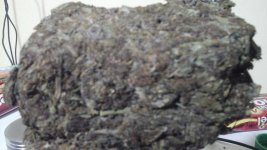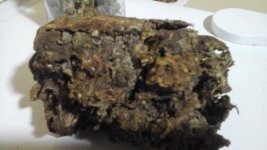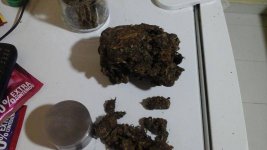rickytheghost
Member
I live in Colombia, and was visiting my girfriends family, and her mom is friends with a grower from Santa Marta.
My gf's family lives in Barranquilla, and the grower comes into the city sporadically to drop off product to his customers. I have been talking to the guy and he wants me to go out to his farm to check out his plants.
I grabbed 50,000 pesos worth (15$) of his smoke the other day when we were hanging out. Its got a spicy woodie almost coffee taste and looks to be cured similar looking like a cob in Tangwena's malawi cob cure thread. The high is psychadelic/trippy, relaxing, and super happy, and make me want to eat anything and everything, super munchies. It has the typical mexican brickweed aroma.
Here are some pics, sorry my tablet doesn't have the best camera




I am still visiting her family so I am in a hotel and can't take better pics.
He was telling me growers from the valle de cauca (Cali area, southern Colombia) are growing cripa which is indica strains from abroad in huge 24 hour veg grows using lights until harvest, and churning out light green hydro weed as they call it here (maybe using light depo?). However it's not grown with water, they grow in soil. These growers from down south are getting twice as much per pound as the guys in santa marta are getting for their traditionally grown brick weed.
He was also telling me traditional cultivars they have grown for generations are still very much around but that growers are super stingy about giving out their seeds. They guard the seeds like secret ingredients in a family recipe. He also said many want to switch to comercial strains and growing techniques so they can push out the light green hydro cripa weed, so they can double their profits.
My gf's family lives in Barranquilla, and the grower comes into the city sporadically to drop off product to his customers. I have been talking to the guy and he wants me to go out to his farm to check out his plants.
I grabbed 50,000 pesos worth (15$) of his smoke the other day when we were hanging out. Its got a spicy woodie almost coffee taste and looks to be cured similar looking like a cob in Tangwena's malawi cob cure thread. The high is psychadelic/trippy, relaxing, and super happy, and make me want to eat anything and everything, super munchies. It has the typical mexican brickweed aroma.
Here are some pics, sorry my tablet doesn't have the best camera
I am still visiting her family so I am in a hotel and can't take better pics.
He was telling me growers from the valle de cauca (Cali area, southern Colombia) are growing cripa which is indica strains from abroad in huge 24 hour veg grows using lights until harvest, and churning out light green hydro weed as they call it here (maybe using light depo?). However it's not grown with water, they grow in soil. These growers from down south are getting twice as much per pound as the guys in santa marta are getting for their traditionally grown brick weed.
He was also telling me traditional cultivars they have grown for generations are still very much around but that growers are super stingy about giving out their seeds. They guard the seeds like secret ingredients in a family recipe. He also said many want to switch to comercial strains and growing techniques so they can push out the light green hydro cripa weed, so they can double their profits.
















